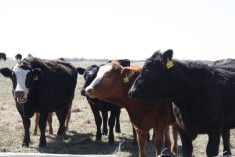This cattle market information is selected from the weekly report from Canfax, a division of the Canadian Cattlemen’s Association. More market information, analysis and statistics are available by becoming a Canfax subscriber by calling 403-275-5110 or at www.canfax.ca.
Fed cattle lower
The Canfax weighted average fed steer price was $173.56 per hundredweight, down $3.65, and heifers were $171.91, down $3.97.
Most of the trade happened midweek.
Delivery dates ranged from the end of February to mid-March.
Read Also

Canfax cattle market report – October 23, 2025
The Canfax cattle market report for October 23, 2025. Fed & feeder cattle prices, butcher cow trends, and cutout market insights.
There was no price incentive to move cattle south. U.S. bids worked back to the low $170s live, depending on freight and dressing percent.
Alberta prices have maintained a $3-$7 premium over Ontario prices this year,.
Fed supplies in Canada are tight, but exports have been brisk, trending above year ago levels.
Weekly Western Canada slaughter to Jan. 30 topped 40,000 for the first time this year but fell to 36,000 head the following week.
Beef cutouts should soon bottom and begin a seasonal rally in March as spring grilling season nears.
Packers in the U.S. Plains paid US$128-$134 per cwt. for cash cattle, down from highs of $136 the previous week.
Some sellers might have been motivated to get cattle out of muddy pens after recent snowstorms.
Cow prices rebound
Fewer animals at auction and good demand helped D1, D2 cow prices bounce back from the previous week’s lows, ranging $100-$113 to average $106.40, up $2.40.
D3 cows ranged $85-$102 to average $93.
Rail prices rose to range $206-$211 per cwt.
Slaughter bulls averaged $128.63, down $3.97.
Feeders lower
Ample supply and soft demand pressured prices down.
There is little American demand, but some eastern Canadian buyers are taking heavy feeders.
Feeder exports in January were the lowest in many years.
With cattle staying in Canada, packers are weakening fed basis levels for later in 2016, adding to the weaker tone in the feeder market.
Most of the pressure is on heavier cattle. Grass cattle have seen only moderate price pressure, thanks to tight supplies and good demand.
Prices for 850 pound steers were the lowest this year and approached the December lows.
Volumes will likely continue higher than a year ago as more backgrounded feeders come to market.
Feedlots will want to pressure heavier feeders lower to try to improve breakevens.
Beef lower
U.S. boxed beef prices searched for a seasonal bottom. Choice cutout was US$217.02 per cwt., down $6, and Select was $214.27, down $4.21.
Demand was slow but might pick up in the next few weeks.
Weekly Canadian boxed beef to Jan. 30 saw AAA at C$305.10, down $6, and AA at $293.82, down $15.
Prairie cattle on feed
There were 919,080 cattle in feedlots in Alberta and Saskatchewan Feb. 1, up six percent from the previous year and close to the five year average.
Placements in January were 98,654, up nine percent.
Cattle heavier than 800 lb. made up much of the increase. The mild winter helped with weight gain.
Marketings in January were 101,323, down seven percent.
The lower marketings,higher placements and reduced feeder exports likely ensure higher cattle on feed numbers through the year.














